Driving Change: ESG as a Catalyst for Sustainability and Positive Contributions


In an era where financial services and businesses are increasingly recognised as integral parts of a broader societal ecosystem, the impact of environmental challenges on the global financial system is gaining heightened attention. Environmentalists and regulators alike are sounding the alarm about the tangible and systemic risks posed by climate change. This awareness is particularly crucial during times of rapid societal change, such as the current convergence of pandemic concerns, climate risks, and economic inequality. As society grapples with these transformative forces, companies are actively exploring innovative strategies to enhance long-term shareholder wealth. In this landscape, the integration of Environmental, Social, and Governance (ESG) aspects into corporate processes, operations, and systems emerges as a powerful strategy, enabling companies to make a positive impact and align with evolving global priorities.
ESG factors that influence the capacity and willingness of a company to meet its financial commitments

Importance of ESG Guidelines
Environmental, social, and governance (ESG) guidelines represent a set of non-financial measures for monitoring and assessing the sustainability of an investment. There has been a rapid growth in awareness regarding corporate misconduct, social injustice, and climate change. As a result, corporate behaviour and sustainability are now essential factors in determining the success and reputation of business entities. ESG standards and guidelines describe how a business should conduct itself concerning the environment and its inhabitants. Adhering to these guidelines is significant because socially conscious investors now evaluate potential investments using ESG criteria.

ESG Guideline: The Dependable Barometer for Sustainability

Today, ESG guidelines have been acting as a dependable barometer for sustainability, serving as a set of standards used by investors to evaluate a company’s operations and assess potential investments. By investing in such measures, banks can take a step towards becoming the kind of institutions their stakeholders value for social and environmental concerns.
In recent months, it has become evident that many businesses are starting to take ESG reporting more seriously. However, these same firms need to be made aware of sustainable practices and the potential reporting requirements for climate risk on the assets and portfolios of their customers in comparison to the worldwide norm set by the Task Force on Climate-Related Finance Disclosures (TCFD), Global Reporting Initiative (GRI), and the Sustainability Accounting Standards Board (SASB).
To make this work accessible and seamless, it is essential to learn and integrate new tools and solutions that can support corporate entities in calculating carbon emissions and reporting. Additionally, these tools can assist in developing trend analysis, risk-based analysis, scenario-based analysis, and the best possible approach for mitigation strategies.
Introducing: KiyaAi’s ESG Solution

KiyaAi’s ESG Solution has been meticulously designed to support ethical business practices, green finance, offer straightforward risk assessment and reporting services to global financial institutions. It represents a carefully designed, cloud-based reporting tool tailored for carbon footprint reduction, climate risk and metrics specific to each financial institution.
This tool encompasses the full spectrum of emissions-related metrics outlined by TCFD, with functionality extending to benchmarking against both global and national standards. Furthermore, it includes estimating requirements aligned with the science-based targets initiative. However, the true advantage for corporate governance lies in the automatically generated risk report, which evaluates distinct elements of climate risk—asset risk, transition risk, concentration risk, event risk, and jurisdictional risk.

In an era where financial services and businesses are increasingly recognised as integral parts of a broader societal ecosystem, the impact of environmental challenges on the global financial system is gaining heightened attention. Environmentalists and regulators alike are sounding the alarm about the tangible and systemic risks posed by climate change. This awareness is particularly crucial during times of rapid societal change, such as the current convergence of pandemic concerns, climate risks, and economic inequality. As society grapples with these transformative forces, companies are actively exploring innovative strategies to enhance long-term shareholder wealth. In this landscape, the integration of Environmental, Social, and Governance (ESG) aspects into corporate processes, operations, and systems emerges as a powerful strategy, enabling companies to make a positive impact and align with evolving global priorities.
ESG factors that influence the capacity and willingness of a company to meet its financial commitments

Importance of ESG Guidelines
Environmental, social, and governance (ESG) guidelines represent a set of non-financial measures for monitoring and assessing the sustainability of an investment. There has been a rapid growth in awareness regarding corporate misconduct, social injustice, and climate change. As a result, corporate behaviour and sustainability are now essential factors in determining the success and reputation of business entities. ESG standards and guidelines describe how a business should conduct itself concerning the environment and its inhabitants. Adhering to these guidelines is significant because socially conscious investors now evaluate potential investments using ESG criteria.

ESG Guideline: The Dependable Barometer for Sustainability

Today, ESG guidelines have been acting as a dependable barometer for sustainability, serving as a set of standards used by investors to evaluate a company’s operations and assess potential investments. By investing in such measures, banks can take a step towards becoming the kind of institutions their stakeholders value for social and environmental concerns.
In recent months, it has become evident that many businesses are starting to take ESG reporting more seriously. However, these same firms need to be made aware of sustainable practices and the potential reporting requirements for climate risk on the assets and portfolios of their customers in comparison to the worldwide norm set by the Task Force on Climate-Related Finance Disclosures (TCFD), Global Reporting Initiative (GRI), and the Sustainability Accounting Standards Board (SASB).
To make this work accessible and seamless, it is essential to learn and integrate new tools and solutions that can support corporate entities in calculating carbon emissions and reporting. Additionally, these tools can assist in developing trend analysis, risk-based analysis, scenario-based analysis, and the best possible approach for mitigation strategies.
Introducing: KiyaAi’s ESG Solution

KiyaAi’s ESG Solution has been meticulously designed to support ethical business practices, green finance, offer straightforward risk assessment and reporting services to global financial institutions. It represents a carefully designed, cloud-based reporting tool tailored for carbon footprint reduction, climate risk and metrics specific to each financial institution.
This tool encompasses the full spectrum of emissions-related metrics outlined by TCFD, with functionality extending to benchmarking against both global and national standards. Furthermore, it includes estimating requirements aligned with the science-based targets initiative. However, the true advantage for corporate governance lies in the automatically generated risk report, which evaluates distinct elements of climate risk—asset risk, transition risk, concentration risk, event risk, and jurisdictional risk.
